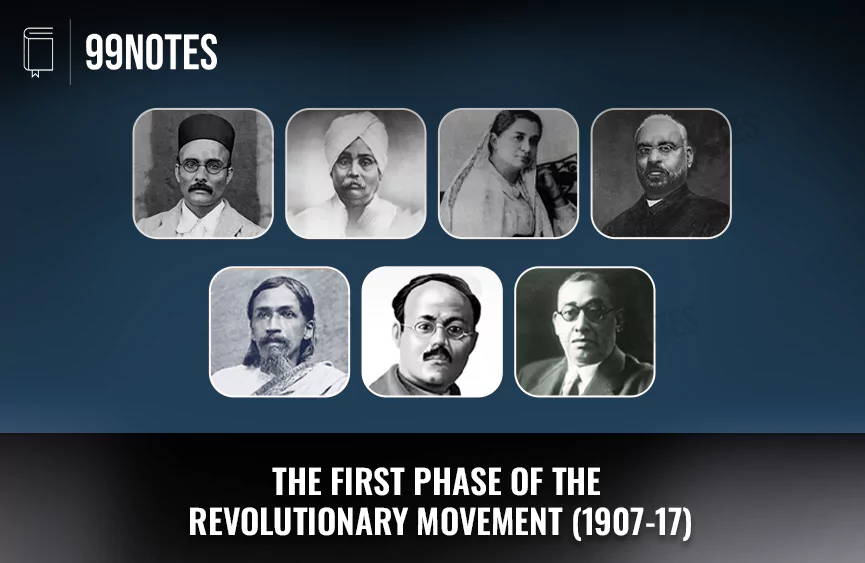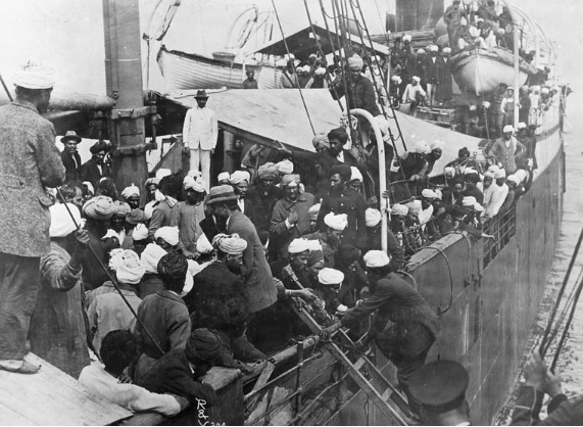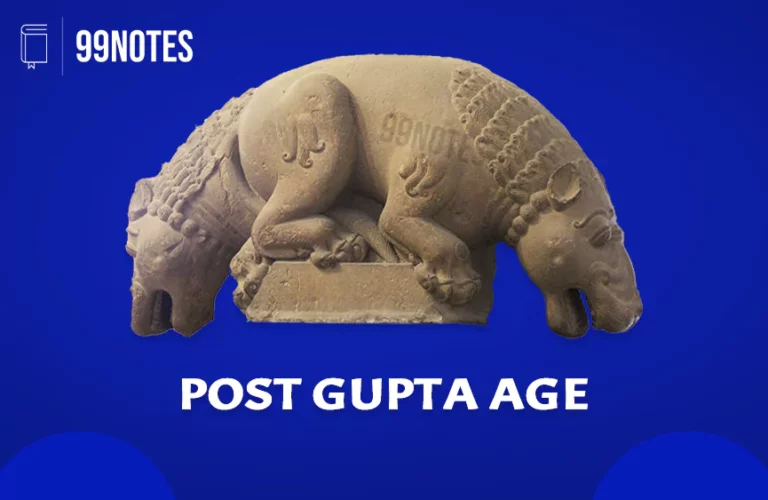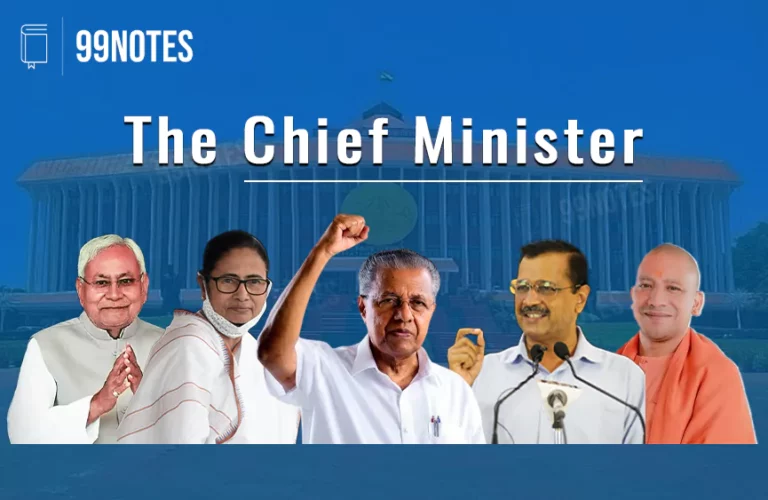Revolutionary Movement in India
The First Phase of the Revolutionary Movement in India (1907-17)
With the decline of the mass phase of the Swadeshi movement and the lack of political activity, a new kind of political action emerged in the national movement. In this aspect, the highly motivated youth adopted the following methods:
- They adopted revolutionary activities as the means to achieve their goal.
- They adopted the methods followed by the Russian Nihilist and Irish Nationalists, which involved individual heroic actions and the assassination of unpopular officers.
Reasons for the Revolutionary Trends
Various reasons play a role in the growth of revolutionary trends:
- The realization of the futility of the constitutional methods: The extremist’s critique of the moderates had convinced the revolutionaries of the futility of the attempt to convince the Britishers by prayers and petitions.
- Disappointment with the Extremist leadership: The revolutionaries were disappointed and impatient with the inability of the extremists to organize full-scale mass mobilization and not secure the reversal of the partition of Bengal.
- The brutal repression of the Swadeshi movement further helped the growth of revolutionary trends. Surat split had enhanced the ability of the government to repress since it had reduced the risk of alienating moderates in the event of the repression of the extremists.
- The policy of Carrot and Stick: Luring the moderates with the promise of constitutional reforms, the government launched an all-out repression of the extremists. Tilak was exiled to Burma for six years, and Aurobindo Ghosh was arrested in a conspiracy case.
Earlier Activities
Though the revolutionary trends in a real sense started only around 1907-08, there had been earlier instances as well as follows:
- In 1897, the Chapekar brothers of Poona, Damodar, and Balkrishna murdered the Plague Commissioner of Poona, Rand.
- In Maharashtra again, VD Savarkar and his brother had organised a secret society named Mitra Mela in 1899, which later merged with Abhinav Bharat (after Mazzini’s Young Italy) in 1904.
Major Activities in Bengal
Bengal became the main centre of revolutionary activities, and many secret societies emerged during this period. The organisation of revolutionary activities was led by the Anushilan and Jugantar societies:
- Anushilan Group:
- In 1902, the first revolutionary groups were formed in Midnapore (By Jnenendranath Basu), and the Anushilan Samiti in Calcutta, founded by Promotha Mitter and the other members were Jatindranath Banarjee, Barindra Kumar Ghosh, etc. But these societies remained dormant till 1907-08.
- In 1906, a group of Anushilan members led by Barindra Kumar Ghosh and Bhupendranath Dutta started a weekly called Yugantar to advocate revolutionary activities.
- Rashbehari Bose and Sachin Sanyal organised a secret society that expanded its operations in Punjab, Delhi, and the United Provinces.
- The first big event of the revolutionary trend was in April 1908, when Prafulla Chaki and Khudiram threw a bomb on a carriage where Kingsford, the unpopular district judge of Muzaffarpur, was supposed to be travelling. But unfortunately, the carriage was carrying two British ladies who were thus inadvertently killed. Prafulla Chaki shot himself dead rather than be arrested, but Khudiram Bose was arrested and later hanged.
- Alipore Conspiracy Case: The Government used the opportunity to crackdown on the Anushilan group, and all of its members were arrested, including Aurobindo Ghosh and his brother Barindra in the Alipore conspiracy case in which Aurobindo himself was acquitted, but his brother and many others were sentenced to deportation and harsh prison terms.
- In 1908, Barrah dacoity was organised by Dacca Anushilan Samiti, under Pulin Das, to raise funds for revolutionary activities.
- Delhi Conspiracy Case: In 1912, a bomb attack was attempted on Viceroy Lord Hardinge when he was entering the new capital of Delhi in a ceremonial procession through Chandni Chowk. However, the Viceroy and Lady Hardinge escaped with injuries. While most of the accused were tried and executed in the Delhi conspiracy case, Rasbehari Bose managed to escape.
- Jugantar Group:
- The western Anushilan Samiti, under the leadership of Jatindranath Mukherjee or Bagha Jatin, emerged as Yugantar (Jugantar).
- During the First World War, the Yugantar party was involved in an Indo-German conspiracy, or the Zimmerman Plan, to overthrow the British rule in India. However, the plan failed due to betrayal, and Bhagha Jatin was shot dead in Balasore, Orissa, in 1915.
Major Activities in Punjab
In Punjab, the extremism was fuelled by the rise of land revenue, frequent famines, the practice of Begar labour by Zamindars, and also what was happening in Bengal. Various leaders played important roles in the Punjab as follows:
- The most active leaders here were Ajit Singh and Lala Lajpat Rai, who brought out ‘Punjabee’. The duo organised Anjuman-i-Mohisban-i-Watan with its journal Bharat Mata.
- In 1907, after the government’s ban on political activities, Ajit Singh, along with Lala Hardayal and others, turned towards revolutionary activities.
Revolutionary activities outside India
Not only were the revolutionary activities prevalent in India but also various revolutionary activities outside India. To evade arrests and censorship of the Press by the British and the quest for arms brought Indian revolutionaries abroad. Some important revolutionary activities outside India are as follows:
- In 1905, Shyamji Krishna Verma started the Indian Home Rule Society or India House, as a centre to promote nationalistic views and work. However, it soon became a major centre of revolutionary activities outside India. VD Savarkar and Hardayal were members of this house. The centre brought a journal, The Indian Sociologist, to spread anti-colonial views.
- In 1909, Madan Lal Dhingra, who was associated with India House, killed Curzon Wylie, an Indian Office official in London.
- Madam Bhikaji Cama, a Parsi revolutionary, operated from Paris and brought out Bande Mataram. She had developed contacts with French socialists.
- Ajit Singh travelled across Europe in his quest to support revolutionary activities. In 1918, he came into contact with the Ghadar Party in San Francisco.
- Virendranath Chattopadhyay made Berlin his base after the deterioration of relations between Britain and Germany. He was involved in the Zimmerman Plan, an Indo-German plot to overthrow British rule in India.
The Ghadr Movement
The Ghadr Party was a revolutionary group set up by Indian expatriates to overthrow British rule in India. The pre-Ghadr activities were carried out by Lala Hardayal and Taraknath Das, among others, organising Indian students and Immigrants for the nationalistic cause. Various aspects of the Ghadr movement are as follows:
- The movement was based on the west coast of Canada and the USA, with its headquarters in San Francisco. It brought out a weekly newspaper, “The Ghadr”.
- The movement was mandated to organise assassinations of unpopular officials, publish revolutionary and anti-imperialist literature, procure arms, work among Indian soldiers stationed abroad and coordinate with revolutionaries in other British colonies.
- The important leaders of this movement were Lala Hardayal, Barkatullah, Bhai Parmanad, Kartar Singh Saraba, Ramchandra and Bhagwan Singh.
- The start of the First World War and Komagata Maru determined the subsequent course of the movement.
- Komagatu Mara was a ship carrying Indian immigrants from Singapore to Vancouver, Canada. On arrival, the ship was not allowed into the port and was rope in by the police.
- Despite the efforts by several of Ghadr’s leaders, they were turned back by the Canadian authorities.
- After the ship reached Calcutta, the hostile attitude of the police led to a clash, which resulted in the death of 18 passengers.
- Infuriated by the Komagata Maru incident and sensing opportunity at the outbreak of the First World War, the leaders of the movement decided to start an uprising against the British rule in India.
- Ghadr leaders Kartar Singh Saraba and Raghubar Dayal Gupta left for India, and Sachin Sanyal and Rasbehari Bose were asked to lead the movement. Political dacoities (Swadeshi dacoities) were committed to fund the movement.
- However, the lack of support from the people of Punjab for a violent rebellion made the leaders spread their message among the soldiers and engineer a mutiny, but due to the lack of proper organisation and centralised leadership, the revolt failed.
- The next attempt was made in February 1915 under the leadership of Rasbehari Bose. But the government, armed with Defense of India rules,1915, managed to infiltrate the movement and foiled it. The movement was effectively crushed. Rasbehari Bose managed to escape to Japan, while Sachin Sanyal was sentenced to life in Cellular Jail in Andaman and Nicobar Islands.
- Evaluation of The Gadr Movement:
- The Ghadr movement was successful in popularising the nationalist ideology, which involved the critique of British colonial rule and its consequences.
- Their ideology had a secular, democratic and egalitarian Essentially a Punjabi Sikh movement, they had Lala Hardayal, a Hindu, Barkatullah, a Muslim and Rasbehari Bose, a Bengali Hindu, as their leaders.
- One of Lala Hardayal’s contributions was giving an international outlook to the movement. He used to give references to Irish, Russian and Mexican revolutionaries in his articles and speeches.
- However, one of the major weaknesses of the movement was its over-estimation of the readiness of the revolt and under-estimation of the British might and ideological foundation of their rule.
- Another weakness of the movement was the almost non-existent organizational structure, and perhaps Lala Hardayal was not suited for the job of leading the organization.
The Decline of The Revolutionary Activities
- Severe repression by the use of stringent laws and lack of mass support led to the gradual decline of revolutionary activities.
- The release of prisoners held under the draconian defense of Indian rules and Montagu’s August 1917 statement regarding constitutional reforms cooled down the revolutionaries temporarily.
- The advent of Gandhi, with his non-violent, non-cooperation movement, gave new hope to people.
Evaluation of the Revolutionary Activities
- Individual heroic actions by the revolutionaries earned them great admiration and sympathy. Revolutionaries like Khudiram Bose and Prafulla Chaki became folk heroes.
- Despite their small number and eventual failure, they made a remarkable contribution to the growth of patriotic zeal and a sense of self-confidence in the country.
- However, their kind of political action could only be followed by a few individuals and not by a mass of people, due to which they lacked a mass base and could not withstand the suppression by the mighty British empire.
- Their method of using violence as a political tool gave justification to the British to commit even more violence.








